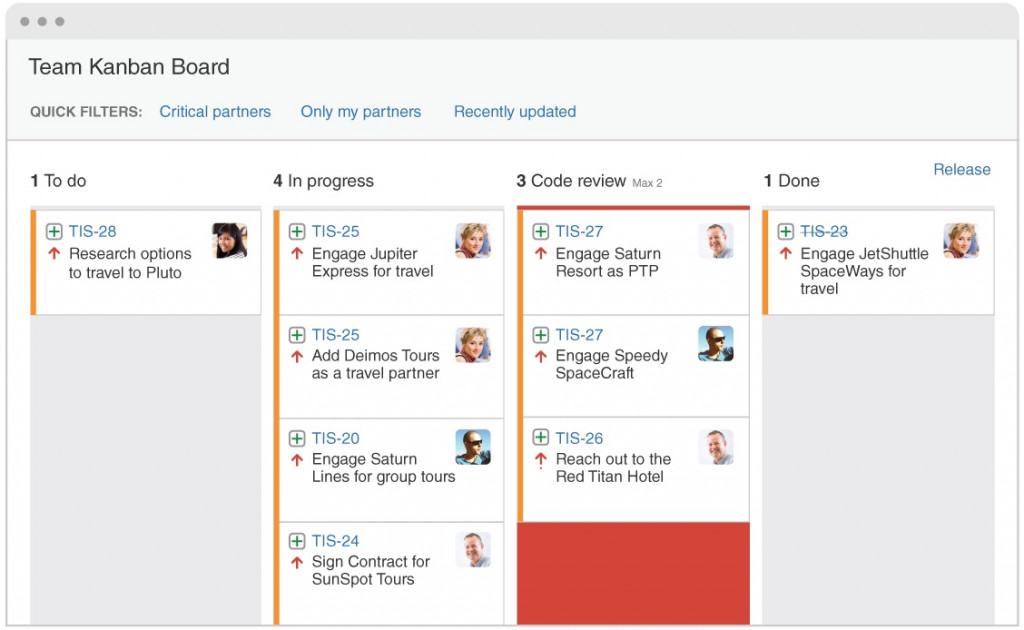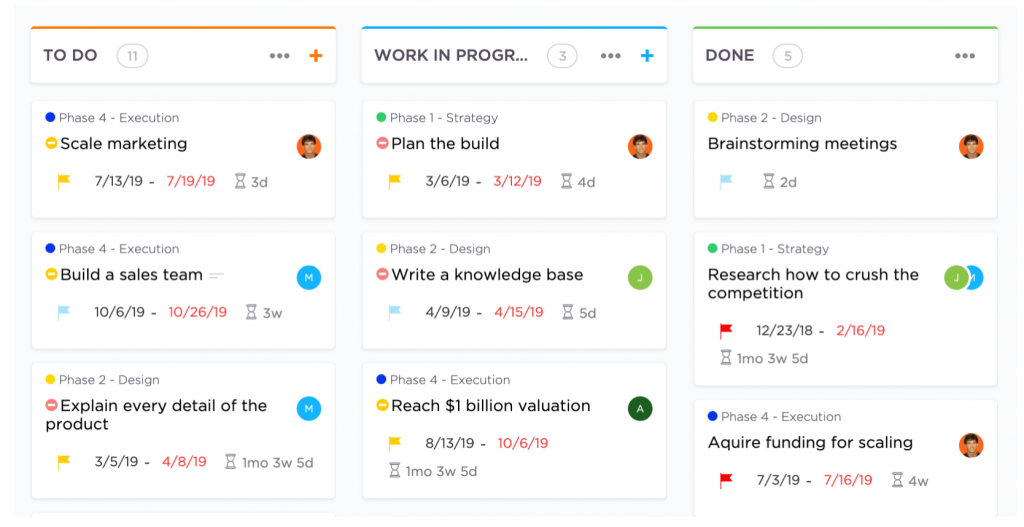How would you compare Kanban vs. Scrum? In simple terms, Scrum is like a bus that follows a predetermined route with stops at the end of each sprint, while Kanban is like a taxi that allows you to make stops wherever and whenever you want. Scrum emphasizes teamwork, time-boxed sprints, and defined roles, while Kanban focuses on continuous delivery, visualizing the workflow, and limiting work in progress.
For example, a software development team working on a new product might use Scrum to plan and execute the development process. In contrast, a customer support team would benefit from Kanban, which allows them to manage incoming requests and prioritize their work based on urgency and impact.
Let’s explore the difference between Scrum and Kanban in a typical digital product agency in more detail and learn how to manage multiple projects effectively.
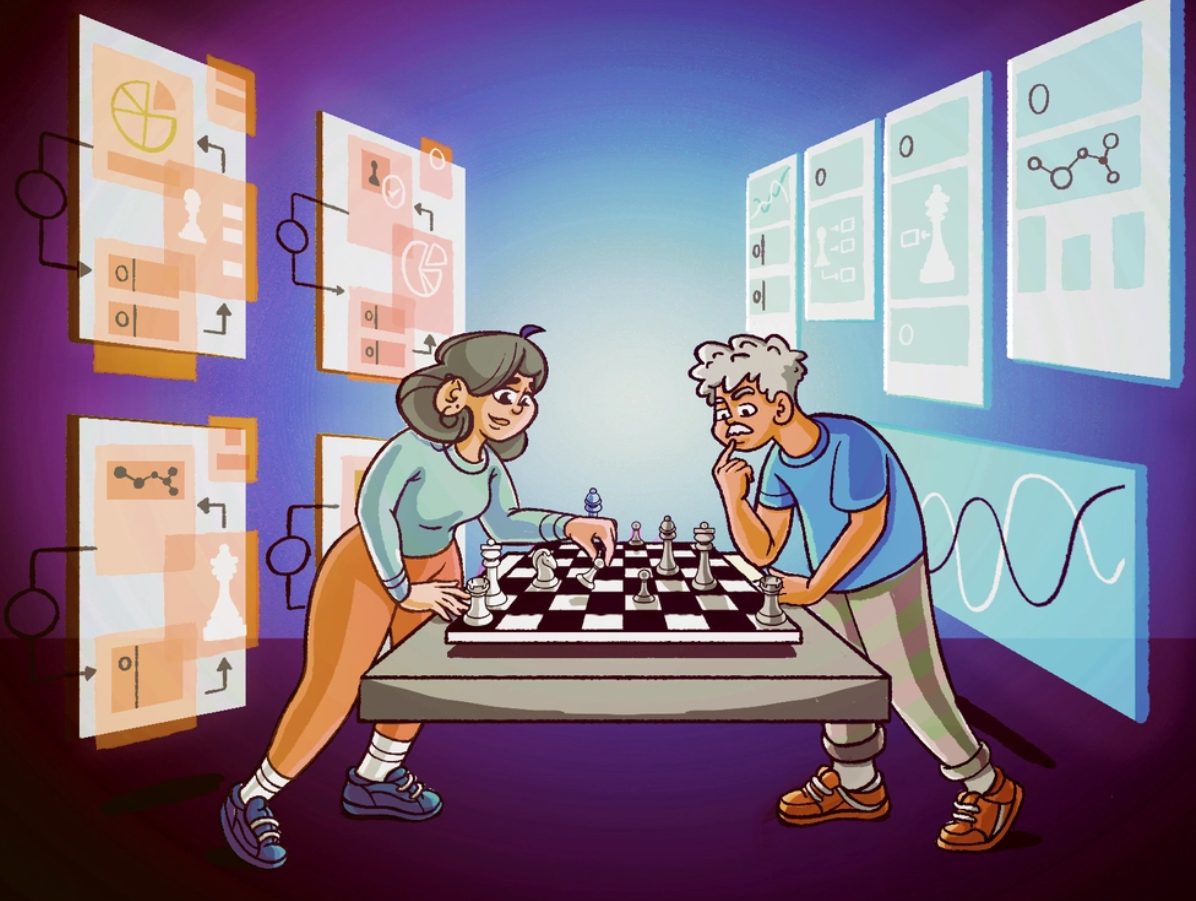
Kanban vs. Scrum: introduction
Everyone involved in Agile will likely have a general idea of both Scrum and Kanban. But people often don’t understand or at least confuse the difference between Kanban and Scrum.
The first step to understanding is to realize that Kanban is not just a task board. Kanban is a structure, a methodology, a process (whatever you may call it), and the Kanban board is its tool. Scrum may also utilize a board that differs from the Kanban board. One of the biggest misconceptions is that someone may call both “a Kanban.”
What is Kanban?
Kanban is a lean method and project management framework that helps visualize tasks and enables continuous flow. The core of the Kanban method is the Kanban board, physical or digital. The board is divided into columns representing project phases (like To Do, In Progress, Done). Tasks are written on cards that move from one column to the next until they’re completed. This helps the team keep track of the project’s progress and ensure it is on track.
Kanban is best suited for projects characterized by:
- continuous and evolving work,
- variable lead times,
- streamlined processes,
- highly collaborative teams, and
- a focus on continuous improvement in environments where fixed scope and deadlines are not predominant.
Kanban provides a flexible approach to managing projects and workflows. Its distinctive features are:
- its emphasis on visualizing work,
- continuous flow,
- pull system,
- WIP limits, and
- adaptability without enforcing specific roles or fixed iterations.
Kanban methodology requires no defined roles.
Key metrics offer insights into workflow efficiency, quality, and areas for improvement:
- Lead Time,
- Cycle Time,
- Throughput,
- Work in Progress (WIP),
- WIP Limits Adherence,
- Blocked Time and
- Blocked Rate.
The specific Kanban metrics a team focuses on can vary based on its goals and context.
What is Scrum?
Scrum is a popular software development framework providing a structured approach to managing complex projects. It consists of iterations called sprints. During a sprint, the team works on prioritized tasks and reviews progress with stakeholders at the end of each sprint. By defining roles, responsibilities, and processes, Scrum helps teams effectively collaborate and communicate. It also provides a schedule for delivering incremental improvements to the product.
Scrum is best suited for projects involving:
- iterative development,
- evolving requirements,
- cross-functional collaboration,
- defined timeframes,
- highly collaborative environments, and
- regular adaptation to changing priorities.
Scrum distinguishes itself from other methodologies through the following:
- its iterative development in fixed-length sprints,
- defined roles,
- key artifacts and ceremonies,
- promoting transparency, inspection, and adaptation to managing complex projects.
Scrum demands clearly assigned team roles: Scrum master, product owner, and development team.
This framework doesn’t prescribe specific key metrics. However, Scrum teams often adopt certain metrics based on industry best practices to gauge performance, progress, and areas for improvement. Key Scrum metrics commonly used for performance measurement and improvement include
- Team Velocity and Capacity,
- Sprint Goals and Burndown,
- Release Burndown,
- Sprint Review Effectiveness and
- Workload distribution.
Kanban vs. Scrum: differences
The key differences between Scrum and Kanban methodologies lie in approaches to Agile management.
In Kanban, you need to complete the task. If not – no problem. You can leave it and return to it when you find the solution.
In Scrum, your goal is to finish the sprint.
To better see the differences in performance, planning, and other project processes of Kanban vs. Scrum, here’s a comparison tip that is much fun to discover, too:
Kanban
Planning: There is no precise planning routine. You plan when you finish items. Balance demand planning and continuous flow.
Estimations of time are optional. When items are completed, teams simply pull the next item from the backlog and implement it. However, there is a limit to how many items can be in the working column simultaneously.
Changes to the work scope: tasks are added as needed.
Roles are assigned as needed.
Meetings: none required.
Ownership: depends on defined roles and necessities.
When to use: changes are too fast, support/maintenance work (operational level), bugfix.
Boards and artifacts: Kanban board, Cumulative Flow Diagram, and Lead and Cycle Time Diagram (which presents the average time for a task to be processed from specific start to finish points).
Scrum
Planning is regular and occurs at the beginning of a sprint.
Estimations of time are required before a sprint starts. Tasks should be small enough to be finished within a sprint. If not, they must be split into smaller tasks.
Changes to the work scope should wait for the next sprint.
Roles: Scrum master, Product owner, development team.
Meetings are necessary:
- Sprint planning (1-4 hours collaborative session),
- Daily Scrum (10-15 minutes, everybody talks about achievements/issues),
- Sprint review (0.5-2 hours, review the results).
Ownership: Product owner.
When to use: small items and small value, adding increments is possible, the requirements are in good shape, a clear roadmap is present, and there are more interdependent teams.
Boards and artifacts: product backlog, sprint backlog, Scrum board, burndown chart.
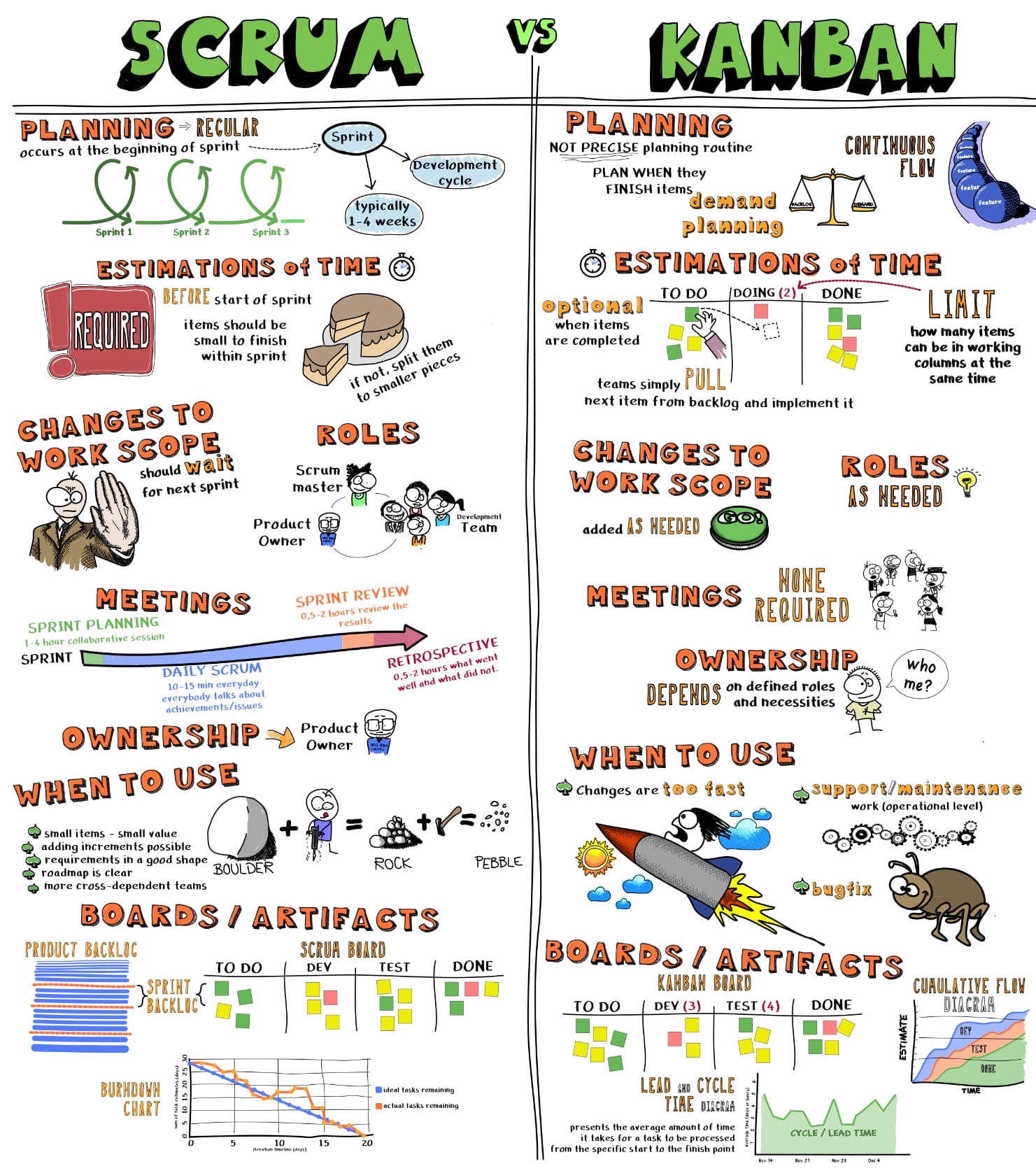
Retrieved from an incredible Medium article.
Kanban vs. Scrum: similarities
Both methods have much in common if we remove all the differences and focus on similarities. Namely:
- Both are referred to as Lean and Agile.
- Both limit WIP.
- Both may use “pull scheduling.”
- They may be focused on delivering the releasable.
- They may use transparency to drive process improvement.
- Breaking the work into pieces is needed.
- Both are based on self-organizing teams and their cadences.
- Both incorporate the best agile communication practices.
If you still cannot determine which is better for your projects, the differences between the boards are worth examining. Each is more suitable for a particular situation, and combining the two may give you the best result.
Kanban board vs. Scrum board
Comparing the Scrum board vs. Kanban board can help you understand the methodologies and tools used in each. Although both employ visual management boards, they differ significantly in their approach.
In Scrum, the board is an extension of the product backlog. After the team commits to a certain amount of work, it is added to the backlog on the Scrum board. Then, the team begins their work on the tasks and puts them in progress on the board as they see fit. Scrum aims to complete all the work by the end of the sprint, and then, the board is reset.
On the other hand, the Kanban board is a team’s workflow representation. Its primary objective is to establish a sustainable Kanban system that will last. A proper Kanban board displays WIP (work in progress) limits, intending to control the amount of work that enters and exits the process to improve delivery speed.
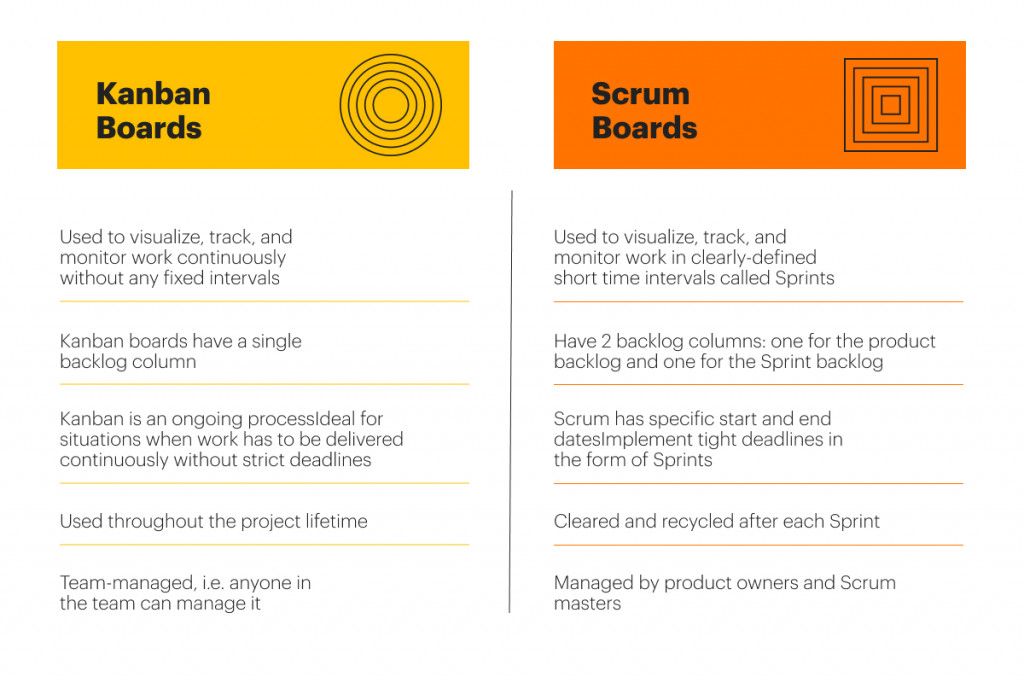
Here are some board examples from the leading services:
Scrum board in Asana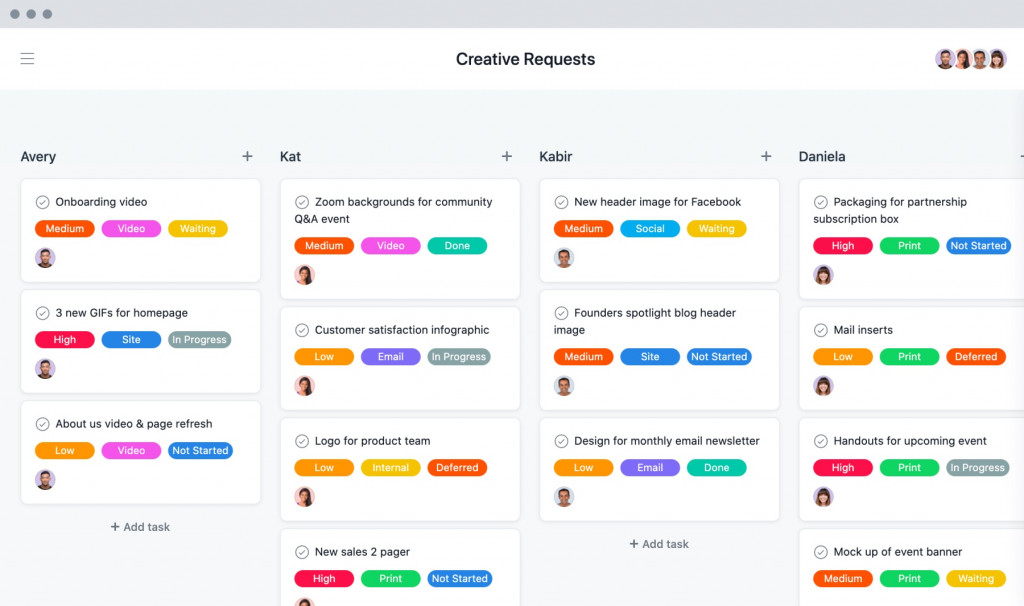
Kanban board in Asana

Scrum board in Jira

Kanban board in Jira
Scrum board in ClickUp

Kanban board in ClickUp
Kanban vs. Scrum: which to choose?
Picking the proper project management system can be daunting, especially when deciding between Scrum vs. Kanban. There is no hard and fast rule to follow when selecting Kanban or Scrum. However, you can consider specific criteria to decide which method is best for your project.
Kanban is the way to go if you need a visual project management system, want a quick view of the project stand, and do not produce work in short periods. It is also suitable for teams that run ongoing processes and projects but are not part of the engineering, product, or software development team.
On the other hand, Scrum is excellent for organizing and prioritizing your entire process. It is ideal for engineering, product, software development, or Agile-based teams with a large backlog of work. Scrum is also well-suited for teams that are motivated by quick deadlines and deliverables and have someone committed to being the Scrum master.
Even without running a Scrum framework, you can draw inspiration from it. You can keep a backlog of work to understand better and prioritize tasks, even if you don’t want your work to be limited to sprints.
One thing to keep in mind is that you can run Scrum on a Kanban board and combine the two. This can help you to get the best of both worlds.
When it’s best to use Scrum
Scrum is an excellent methodology for product development services. This method involves dividing your organization into small, cross-functional, self-organizing teams. You define work for the next sprint, set a backlog, and establish KPIs. Then, you block the sprint and perform the work.
Scrum is beneficial when a project has a complex and unpredictable scope of work, and the requirements are not well-defined or are likely to change. It allows teams to work in short sprints and deliver value at the end of each sprint.
It is precisely what is needed for:
- developing new products,
- complex software development,
- prototyping and testing, and
- marketing campaigns.
Scrum is often the best choice for software development projects because it promotes collaboration and transparency among team members. It provides designated roles, ceremonies, and artifacts that encourage regular communication and feedback. Scrum ensures that everyone knows the project’s progress and emerging issues and helps to build trust and accountability within the team.
When it’s best to use Kanban
Kanban is better suited to support production with little planning and control. It provides flexibility for projects with a high volume of work and frequent changes. Kanban limits the number of work in progress and focuses on completing tasks one at a time.
Typically, it works well for
- software development and maintenance,
- IT support,
- creative design,
- research and development, and
- customer support.
Kanban is ideal for teams that want to improve their processes continuously. By monitoring and measuring performance, teams can identify improvement areas and make changes to optimize their workflow.
Kanban boards provide a clear picture of the work that needs to be done, who is responsible for each task, and the status of each item. This makes identifying bottlenecks easy, prioritizing work, and adjusting easy.
Conclusion
Choosing between Kanban vs. Scrum project management framework largely depends on your organization’s needs. While Scrum is more structured and better suited for fast-paced, iterative projects, Kanban is more flexible and ideal for projects with constantly changing priorities.
At Fireart, we have extensive experience delivering projects using both methods and can recommend the best approach for each case. Our managers are always available to provide detailed information and guidance on which methodology to choose for your project. Contact our professionals today to learn more.
FAQ
Kanban vs. Scrum – what is better?
Both Kanban and Scrum are popular project management methodologies used in Agile development. While Scrum is more structured and prescriptive, Kanban is more flexible and adaptive. Scrum best suits complex and rapidly changing projects, while Kanban is more suitable for continuous and predictable workflows. Ultimately, the choice between Kanban and Scrum depends on the project and the team’s specific needs and characteristics.
Kanban vs. Scrum: what is the difference?
Kanban and Scrum are Agile methodologies used in software development to manage and prioritize tasks. The main differences between Kanban and Scrum are as follows:
- Scrum is an iterative approach focusing on sprint planning and daily stand-ups,
- Kanban is a continuous flow approach emphasizing completing individual tasks as soon as possible,
- Scrum works well for projects with a defined scope and strict deadlines,
- Kanban is best suited for projects that require a flexible and adaptive approach.
Is Kanban Agile?
Kanban is often considered an Agile methodology, but some experts argue it is not necessarily part of the Agile framework. While Kanban shares some principles with Agile, such as continuous delivery and incremental improvements, it differs in its focus on visualizing work and limiting work in progress. Kanban prioritizes flexibility and adaptability over rigid processes and prescriptive frameworks, a core tenet of the Agile manifesto. Whether Kanban is considered Agile depends on how one defines and interprets the methodology.
Is Jira a Scrum or Kanban?
As one of project management tools, Jira is compatible with Scrum and Kanban methodologies. Scrum emphasizes iterative and incremental product delivery, while Kanban effectively manages work that emphasizes just-in-time delivery. Jira offers features and customization options, including backlogs, boards, sprints, workflows, and reporting, to support teams using either methodology. Teams can choose the methodology that best suits their needs and configure Jira accordingly to help them manage their work efficiently.
Should I use Scrum or Kanban for product development?
Scrum and Kanban are Agile project management methodologies suitable for product development. Scrum works best for complex projects where requirements are likely to change frequently, and a consistent sprint cycle is crucial. Kanban is suited for projects with more stable requirements and a need for a continuous workflow. Ultimately, the choice between Scrum vs. Kanban will depend on the specific conditions of your team and project. Experimenting with both methodologies and seeing which works best for your team may be helpful.


